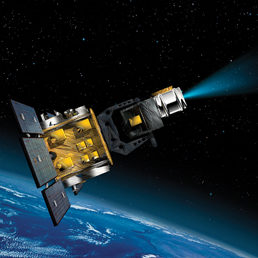The Space Force wants to “pivot” and change how it does space domain awareness with a new generation of capabilities, and it wants industry to take a leading role in shaping that future, a top official said this week.
Earlier this year, Chief of Space Operations Gen. B. Chance Saltzman said “actionable” space domain awareness is essential for his Competitive Endurance theory, which is meant to guide the entire service. Col. Bryon McClain is leading that push as program executive officer for SDA and combat power.
McClain’s team took their first big step earlier this spring when they released a request for information from industry about ideas for space domain awareness in geosynchronous orbit.
Right now, the Space Force relies on five Geosynchronous Space Situational Awareness Program satellites to monitor GEO, along with one Space Based Space Surveillance satellite and the secretive “SILENTBARKER” collaboration with the National Reconnaissance Office.
But as the entire service shifts towards smaller, proliferated satellites and dynamic operations, space domain awareness will likely follow suit, McClain said June 4 during the C4ISRNET conference.
“I think this is really where we’re trying to pivot and do things differently,” said McClain. Specifically, he cited the influence of assistant secretary of the Air Force for space acquisition and integration Frank Calvelli—who has emphasized larger numbers of small satellites, delivered quickly—and Vice Chief of Space Operations Gen. Michael A. Guetlein, former Space Systems Command boss—who has argued the service should only build new satellites when it cannot use existing systems or buy commercial capabilities.
“Those two ideas, those mentalities really go hand in hand,” McClain said. And we’ve tried to embody that in this RFI, which means … a whole bunch of different ideas that really could mix together.”
Specifically, the RFI suggests McClain’s office is interested in multiple satellites that can be refueled and move around to get closer to other objects on orbit, that can integrate into existing networks and ground stations and be built quickly and cheaply.
Many specific requirements, however, were not included in the request, which McClain said was a deliberate choice.
“Instead of the more traditional system, we just opened up the door and said, ‘Hey, I don’t want to share any requirements documents, because that starts getting into the classified world,'” he said. “‘But I want to figure out what you think you can do in this area.’ Huge number of responses.”
McClain’s team is sorting through those responses and planning to speak with Guardians who perform SDA missions every day, asking them what they need and what ideas could address that need.
“Sometimes, we spend too much time thinking we can always guarantee the outcome and know exactly what’s the most important thing,” McClain said. “And so we miss new innovations and new ideas from industry. So we’ll try to flip the script a little bit here and take industry and use that to influence our requirements script, which is why don’t have a specific answer for what we’re looking for.”
Given fiscal constraints, progress on these new SDA systems may take a few years, McClain said. In its 2025 budget request, the Space Force focused heavily on missile warning/missile tracking and satellite communications—missile warning programs accounted for $4.7 billion or 25 percent of the research budget, while SATCOM got more than $1.6 billion, 8.8 percent. Space domain awareness systems, by comparison, got around $484 million, just 2.6 percent.
“The future for some of that RFI may not be until the 2026-27 timeframe, for some of the uniqueness of it and some of the new ideas,” McClain warned. “You may not see immediate action on it.”
In the interim, the service could eye commercial capabilities as a way to close the gap. In its new Commercial Space Integration Strategy released in April, the Space Force ranked SDA second among all mission areas in terms of commercial market maturity and the urgency of military requirements.
To implement that strategy, McClain said, his office needs to understand the commercial marketplace and make sure that the requirements they do set don’t exclude commercial solutions.

